INSTITUT SUPERIEUR D'ANTHROPOLOGIE
INSTITUTE OF ANTHROPOLOGY
ONLINE COURSES / COURS A DISTANCE
FALL TERM : OCTOBER 2015
REGISTER NOW
USA –  Richmond - The city of Richmond moved a step closer this week to digging beneath a Shockoe Bottom parking lot that may hold relics of the tobacco industry, the Confederacy and the slave trade.Built in 1810, the tobacco warehouse was used later as a receiving hospital for wounded Confederate soldiers. The building was located around 212 N. 18th St., behind the Exxon gas station on East Broad Street. After falling into disrepair, it was torn down and sold for scrap in 1910. The area was used later as a playground. In 1834, two businessmen advertised that they were “prepared to take slaves for safe-keeping” at a location next to the Seabrook Warehouse. Most of the Richmond slave trade was located closer to where Interstate 95 stands today. But the Seabrook site is perhaps the clearest area of overlap between the proposed development plan and a potentially significant historic site.
Richmond - The city of Richmond moved a step closer this week to digging beneath a Shockoe Bottom parking lot that may hold relics of the tobacco industry, the Confederacy and the slave trade.Built in 1810, the tobacco warehouse was used later as a receiving hospital for wounded Confederate soldiers. The building was located around 212 N. 18th St., behind the Exxon gas station on East Broad Street. After falling into disrepair, it was torn down and sold for scrap in 1910. The area was used later as a playground. In 1834, two businessmen advertised that they were “prepared to take slaves for safe-keeping” at a location next to the Seabrook Warehouse. Most of the Richmond slave trade was located closer to where Interstate 95 stands today. But the Seabrook site is perhaps the clearest area of overlap between the proposed development plan and a potentially significant historic site.
http://www.richmond.com/news/local/city-of-richmond/article_ae8e4fe4-bc06-580d-82a8-375e524151cd.html
INDE – 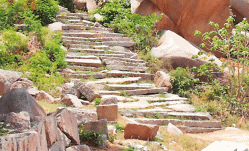 Hampi - Archaeological Survey of India (ASI), state archaeology department and Hampi World Heritage Area Management Authority (HWHAMA) are the three principle authorities meant for conservation of UNESCO world heritage site-Hampi. However, the lack of coordination between these three authorities is proving disastrous for the world heritage site. After the controversial construction of a concrete road on the ancient Kamalapura tank bund which falls within the core zone of the heritage site, state archaeology department and HWHAMA have begun construction of footsteps at the ancient Mathanga hills, a protected monument of the archaeology department, using cement and stone blocks throwing norms to the winds.ASI, Hampi authorities have objected to the construction of the footsteps to reach the hill that is over 500 feet high. An agreement entered into by the authorities concerned approving the construction of the footsteps says the footsteps existed in ancient times and now, many of them had sunk causing inconvenience.
Hampi - Archaeological Survey of India (ASI), state archaeology department and Hampi World Heritage Area Management Authority (HWHAMA) are the three principle authorities meant for conservation of UNESCO world heritage site-Hampi. However, the lack of coordination between these three authorities is proving disastrous for the world heritage site. After the controversial construction of a concrete road on the ancient Kamalapura tank bund which falls within the core zone of the heritage site, state archaeology department and HWHAMA have begun construction of footsteps at the ancient Mathanga hills, a protected monument of the archaeology department, using cement and stone blocks throwing norms to the winds.ASI, Hampi authorities have objected to the construction of the footsteps to reach the hill that is over 500 feet high. An agreement entered into by the authorities concerned approving the construction of the footsteps says the footsteps existed in ancient times and now, many of them had sunk causing inconvenience.
http://www.deccanchronicle.com/150429/nation-current-affairs/article/hampi-tragedy-co-ordination-ruins
INDE – 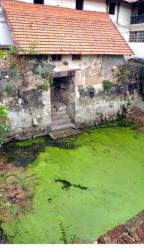 Thiruvananthapuram - Rumours that surfaced on Sunday about the discovery of a secret pathway from Sreepadam Pond leading to Sreepadam Palace, adjacent to Sree Padmanabhaswamy Temple, have been confirmed to be true. The pathway, akin to an entrance with stairs leading down to a bathing spot, was discovered on Sunday when labourers employed by the Archaeology Department to clean the pond, pumped out water measuring nearly four ft and shovelled out nearly 1.5 ft of mud. The pond, according to G. Premkumar, Director, Archaeology Department, was not cleaned, at least for the past 40 to 50 years. Work on converting Sreepadam Palace, one of the oldest palaces in the State, into a heritage museum began recently, with the cleaning of the pond launched on April 20. Water was pumped out on the first four days and mud was being taken out when the door was discovered. At least four more ft of mud remains to be cleaned out, Mr. Premkumar said. “The door found on Sunday is connected to Sreepadam Palace.
Thiruvananthapuram - Rumours that surfaced on Sunday about the discovery of a secret pathway from Sreepadam Pond leading to Sreepadam Palace, adjacent to Sree Padmanabhaswamy Temple, have been confirmed to be true. The pathway, akin to an entrance with stairs leading down to a bathing spot, was discovered on Sunday when labourers employed by the Archaeology Department to clean the pond, pumped out water measuring nearly four ft and shovelled out nearly 1.5 ft of mud. The pond, according to G. Premkumar, Director, Archaeology Department, was not cleaned, at least for the past 40 to 50 years. Work on converting Sreepadam Palace, one of the oldest palaces in the State, into a heritage museum began recently, with the cleaning of the pond launched on April 20. Water was pumped out on the first four days and mud was being taken out when the door was discovered. At least four more ft of mud remains to be cleaned out, Mr. Premkumar said. “The door found on Sunday is connected to Sreepadam Palace.
http://www.thehindu.com/news/cities/Thiruvananthapuram/secret-pathway-is-no-rumour/article7152851.ece
INDE –  Vannathiparai - Mangala Devi Kannagi Temple can be renovated but a sketch or portrait of the original temple is required to restore it to its original shape, according to G. Premnath, Director, Department of Archaeology, Kerala. The Department of Archaeology had been studying the temple’s history and collecting other details. The only evidence for the temple available in Tamil literature was in Silappathikaram. The temple was constructed 1,800 years ago and the structure was now in a dilapidated condition, he added.
Vannathiparai - Mangala Devi Kannagi Temple can be renovated but a sketch or portrait of the original temple is required to restore it to its original shape, according to G. Premnath, Director, Department of Archaeology, Kerala. The Department of Archaeology had been studying the temple’s history and collecting other details. The only evidence for the temple available in Tamil literature was in Silappathikaram. The temple was constructed 1,800 years ago and the structure was now in a dilapidated condition, he added.
http://www.thehindu.com/news/national/tamil-nadu/kannagi-temple-renovation-possible-says-archaeologist/article7152984.ece
INDE - Bavikonda Hill - The 2000-year-old Buddhist heritage site on Bavikonda Hill near Bheemili Road seems to be facing a threat of encroachment as a part of the hill, very close to the heritage site, has been fenced off allegedly for private construction activity against archaeological norms. The Bavikonda Buddhist Complex, located atop a 130-metre hill nearly 20 km from the Port City, is one of the four Buddhist heritage sites in the district and is situated close to the Thotlakonda Buddhist heritage site.
http://timesofindia.indiatimes.com/city/visakhapatnam/Encroachments-eating-into-Bavikonda-Hill/articleshow/47090740.cms
EGYPTE – 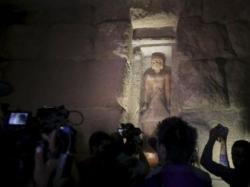 Gizeh - Two ancient tombs belonging to the priest of King Khufu and his son were opened to the public in Giza Pyramids Plateau on Monday April 27 after the end of maintenance works. Antiquities Minister Mamdouh al-Damaty opened the two tombs located in the western cemetery of the plateau. They date back to the fifth dynasty. A new route leading directing to the two tombs were built to facilitate visitors' journeys. The two tombs were discovered in 1925 by US archaeologist George Andrew Reisner.
Gizeh - Two ancient tombs belonging to the priest of King Khufu and his son were opened to the public in Giza Pyramids Plateau on Monday April 27 after the end of maintenance works. Antiquities Minister Mamdouh al-Damaty opened the two tombs located in the western cemetery of the plateau. They date back to the fifth dynasty. A new route leading directing to the two tombs were built to facilitate visitors' journeys. The two tombs were discovered in 1925 by US archaeologist George Andrew Reisner.
http://www.egyptindependent.com//news/two-ancient-tombs-open-public-pyramids-plateau-0
INDE – 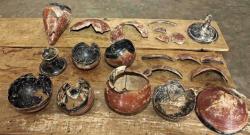 Vadamalakunda - An early Iron Age megalithic burial site dated to black and red ware period was excavated here at Vadamalakunda along the forested area of Krishnagiri-Andhra Pradesh border. The stone-built cist burials were hit upon by a two-member archaeology team from Chandrashekarendra Sarawathi Vishwa Maha Vidyalaya, Kancheepuram, here. The team had been working at the site for about a week. The megalithic site with cist burials was found with human bones, black and red ware, dating it to over 2,500 years. The cists were found with iron objects of rudimentary forms including an axe, chisel, and conical shaped urns, bowls, plates, lids – all made of black and red ware. Each of the black and red ware bore graffiti. A few stone slabs that were part of the parallelepipeds were also found at the site. Ramakrishna Pisipaty, geo-archaeologist, Chandrashekarendra Sarawathi Vishwa Maha Vidyalaya, said cist burial was one form of megalithic burial and may hold full human remains or partial remains, signifying a secondary burial site as in this case. “The Vadamalakunda spread over several acres with more than 200 burials is a disturbed site, with a few burials found today. It calls for further study on the Iron Age settlement here and socio-cultural aspects. The exact period may be discerned only post carbon-testing of the bones,” Mr. Ramakrishna Pisipaty told The Hindu .
Vadamalakunda - An early Iron Age megalithic burial site dated to black and red ware period was excavated here at Vadamalakunda along the forested area of Krishnagiri-Andhra Pradesh border. The stone-built cist burials were hit upon by a two-member archaeology team from Chandrashekarendra Sarawathi Vishwa Maha Vidyalaya, Kancheepuram, here. The team had been working at the site for about a week. The megalithic site with cist burials was found with human bones, black and red ware, dating it to over 2,500 years. The cists were found with iron objects of rudimentary forms including an axe, chisel, and conical shaped urns, bowls, plates, lids – all made of black and red ware. Each of the black and red ware bore graffiti. A few stone slabs that were part of the parallelepipeds were also found at the site. Ramakrishna Pisipaty, geo-archaeologist, Chandrashekarendra Sarawathi Vishwa Maha Vidyalaya, said cist burial was one form of megalithic burial and may hold full human remains or partial remains, signifying a secondary burial site as in this case. “The Vadamalakunda spread over several acres with more than 200 burials is a disturbed site, with a few burials found today. It calls for further study on the Iron Age settlement here and socio-cultural aspects. The exact period may be discerned only post carbon-testing of the bones,” Mr. Ramakrishna Pisipaty told The Hindu .
http://www.thehindu.com/news/national/tamil-nadu/iron-age-megalithic-burial-site-found-in-krishnagiri/article7152408.ece?ref=tpnews
BELGIQUE – 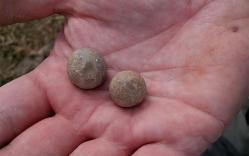
 Waterloo - Archaeologists and veterans excavating the Waterloo battlefield have found spent musket balls from some of the first shots exchanged between the French and Allied troops. The discovery was made at Hougoumont farm in Belgium, a Napoleonic farmhouse that was defended against seemingly impossible odds by the Coldstream Guards. Military historians hope the excavations will uncover mass graves of the tens of thousands of soldiers who died on the battlefield, an area of a former woodland which was bitterly fought over in 1815. Experts also discovered three horse chestnut trees which they believe are riddled with musket balls, after sophisticated metal detectors revealed a high concentration of metal inside the trees.Archaeologists plotted the GPS co-ordinates of their finds on the the military historian William Sibourne's battlefield map from the 1830s, which showed a distinct pattern of heavy fighting on the western side of the wood.The yellow marks show musket balls and pistol balls - both French and British - while the white marks show other metal items form the Napoleonic era such as badges and buttons in a clear line leading back from the edge of the wood back to the farmhouse.
Waterloo - Archaeologists and veterans excavating the Waterloo battlefield have found spent musket balls from some of the first shots exchanged between the French and Allied troops. The discovery was made at Hougoumont farm in Belgium, a Napoleonic farmhouse that was defended against seemingly impossible odds by the Coldstream Guards. Military historians hope the excavations will uncover mass graves of the tens of thousands of soldiers who died on the battlefield, an area of a former woodland which was bitterly fought over in 1815. Experts also discovered three horse chestnut trees which they believe are riddled with musket balls, after sophisticated metal detectors revealed a high concentration of metal inside the trees.Archaeologists plotted the GPS co-ordinates of their finds on the the military historian William Sibourne's battlefield map from the 1830s, which showed a distinct pattern of heavy fighting on the western side of the wood.The yellow marks show musket balls and pistol balls - both French and British - while the white marks show other metal items form the Napoleonic era such as badges and buttons in a clear line leading back from the edge of the wood back to the farmhouse.
http://www.telegraph.co.uk/news/earth/11571467/Musket-balls-discovered-from-first-shots-fired-at-Battle-of-Waterloo.html